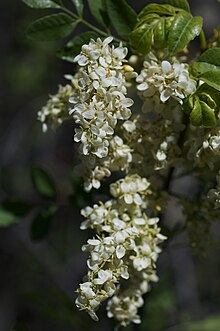
Fraxinus dipetala

| Fraxinus dipetala | |
|---|---|

| |
| Scientific classification | |
| Kingdom: | Plantae |
| Clade: | Tracheophytes |
| Clade: | Angiosperms |
| Clade: | Eudicots |
| Clade: | Asterids |
| Order: | Lamiales |
| Family: | Oleaceae |
| Genus: | Fraxinus |
| Section: | Fraxinus sect. Dipetalae |
| Species: | F. dipetala
|
| Binomial name | |
| Fraxinus dipetala | |

| |
| Natural range | |
Fraxinus dipetala, the California ash or two-petal ash, is a species of ash native to southwestern North America in the United States in northwestern Arizona, California, southern Nevada, and Utah, and in Mexico in northern Baja California. It grows at altitudes of 100–1,300 m.[1][2][3]

It is a deciduous shrub or small tree growing to 7 m tall, with cylindric to four-angled stems. The leaves are 5–19 cm long, light to dark green, with three to seven (rarely nine) leaflets 1–7 cm long, thick, and serrated along the margins. The flowers have two white lobe-shaped petals 2.5–4 mm long, and are sweetly scented, hanging in fluffy clusters; unlike many ashes, they are bisexual, not dioecious. The fruit is a long, flat samara 2–3.2 cm long and 5–9 mm broad, green when immature and hanging in bunches.[3][4]

References
- ^ a b Oldfield, S.; Samain, M.-S.; Martínez Salas, E.; Westwood, M. (2017). "Fraxinus dipetala". IUCN Red List of Threatened Species. 2017: e.T96443856A96443862. doi:10.2305/IUCN.UK.2017-3.RLTS.T96443856A96443862.en. Retrieved 22 May 2024.
- ^ "Fraxinus dipetala". Germplasm Resources Information Network. Agricultural Research Service, United States Department of Agriculture. Retrieved 21 January 2018.
- ^ a b Jepson Flora: Fraxinus dipetala
- ^ Calphotos: Fraxinus dipetala photos
- IUCN Red List least concern species
- Fraxinus
- Trees of Northern America
- Natural history of the California chaparral and woodlands
- Flora of California
- Flora of the Sierra Nevada (United States)
- Natural history of the California Coast Ranges
- Natural history of the Peninsular Ranges
- Natural history of the San Francisco Bay Area
- Natural history of the Santa Monica Mountains
- Natural history of the Transverse Ranges
- Plants described in 1839
See what we do next...
OR
By submitting your email or phone number, you're giving mschf permission to send you email and/or recurring marketing texts. Data rates may apply. Text stop to cancel, help for help.
Success: You're subscribed now !

